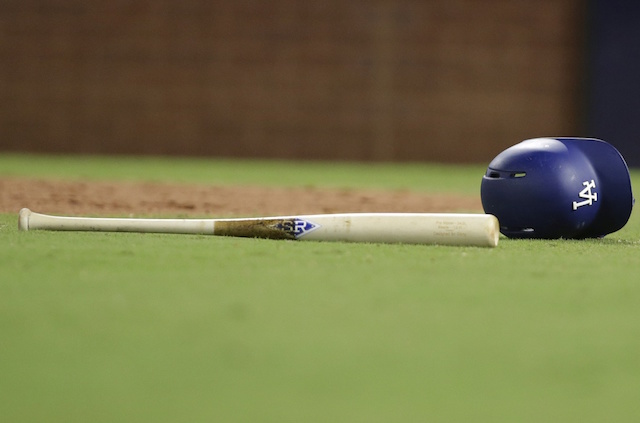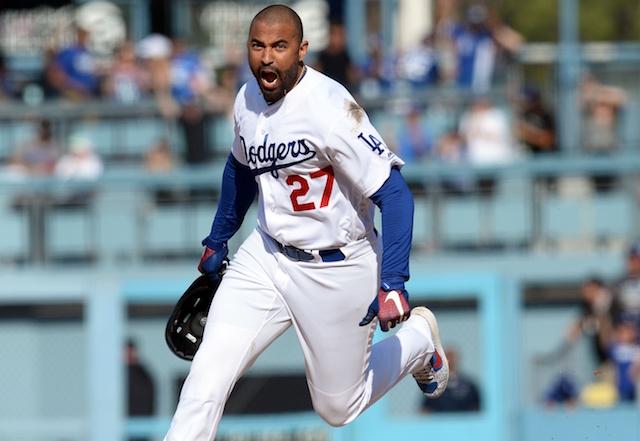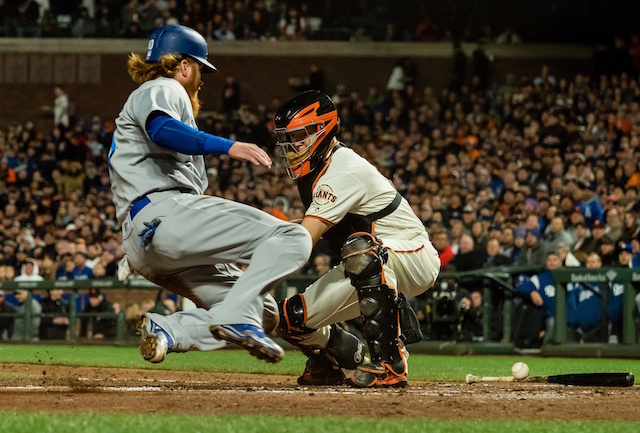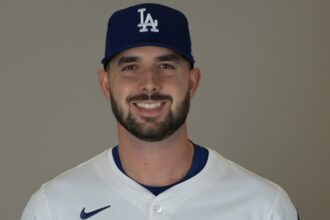Last year, the Los Angeles Dodgers signed Diego Cartaya, MLB.com’s No. 1 ranked international free agent. That naturally stirred up plenty of excitement, as Cartaya added to an embarrassment of riches at the position that already included Keibert Ruiz and Will Smith.
This year, however, there’s been far less attention devoted to fellow Venezuelan Luis Rodriguez, another consensus top five prospect in the 2019-20 international signing period class who was inked by Dodgers.
But make no mistake, ‘L-Rod’ is just about as elite as Cartaya was (though Cartaya’s positional value is relevant here, as it is more valuable).
Rodriguez looks like a plus-hitter with potential plus-power, and he’s impressed scouts with his performance against high velocity pitchers. He’s got a beautiful swing with power to all fields, and makes it hard to remember he’s just 16 years old.
While he’s a center fielder right now, and has a strong arm and is a good defender, he’s an average runner and might profile better in right field in the future. Regardless, his bat will play anywhere, and is immediately one of the can’t-miss prospects in the Dodgers system.
Rodriguez is the type of top level international talent that the Dodgers were barred from signing in the 2016-17 and 2017-18 periods, and will come in squarely as one of the top 20 or so prospects in the system.
He should see himself on the Diego Cartaya/Alex De Jesus pathway, having a short stint in the Dominican Summer League before moving to the Arizona League sometime next summer. Ben Badler of Baseball America captured some video of Rodriguez’s swing.
The Dodgers also signed Kristian Cardozo, a Venezuelan righty, who’s ranked comparably to Jerming Rosario was last year. Cardozo has been up to 92 mph and also features a curveball and changeup, and his fastball has some tailing action as well.
Scouts like his demeanor on the mound and he has starter traits and frame (6’1, 175 lbs.). Cardozo repeats his delivery well and is a good strike-thrower for his age. He should spend all of 2020 in the DSL, then hopefully see some action in the United States in 2021. Here’s video of Cardozo pitching.
Yeiner Fernandez was a star in the 2015 Little League World Series for Venezuela, and according to FanGraphs, his deal with the Dodgers was one of the first done in the class. Fernandez adds another catching prospect to watch to a system already loaded with them, and he’s good enough behind the plate to stay there for the foreseeable future.
He’s not super physically projectable at 5’11, 189 lbs., but is toolsy enough already that it isn’t so much of a concern. Video of Fernandez here.
Dominican shortstop Darol Garcia reportedly received a $200,000 signing bonus from the Dodgers, which is the only known bonus so far, since Venezuelan players’ bonuses are often not reported, due to the tenuous political conditions in the country, where players and their families have been targeted in the past for kidnappings, robberies, and other financially incentivized crimes.
Garcia is a slick fielder at shortstop who looks like he can stay there, and he’s got a big leg kick in his swing, which also suits him well with the Dodgers. Here’s a video of Garcia.
Venezuelan outfielder Victor Sosa has a pretty swing and drives the ball well for his age. There haven’t been any reports on his defense, but you can see him at the plate in this video.
Lefty Eduardo Dominguez carries the rare distinction of being from Spain, who haven’t had an MLB player since the last millennium. Dominguez is a little older, as he’s already 17, but is a very projectable 6’3 on the mound.
He’s reportedly only sat in the mid-80s with his fastball, but there’s hope that he can up that with some development time in a Major League program. If he does, he can pair it with a curveball that is absolutely filthy. It would be interesting to learn what the spin rates on these pitches are.
The Dodgers have also signed Venezuelan right-hander Juan Idrogo, Dominican outfielder Emilio Dotel, Dominican righty Carlos Martinez, Colombian right-handed pitcher Jean Carlos Herrera, Venezuelan right-hander Jose Grateron and Venezuelan shortstop Jose Hernandez.
In addition, they’ve signed right-handers Lioner Vasquez and Waylin Santana, lefty Alberluis Matos and outfielder Yohensy Segura, whose nationalities have not been reported. Reports are scant on all of these players, and we may not learn more about them until the fall Instructional League or next summer, when they’ll likely begin playing in the DSL.
The Dodgers are also rumored to be signing Taiwanese righty Cheng Hao-Chun for $200,000. Hao-Chun is 6’2, 196 lbs., and has been up to 95 mph to go along with a solid breaking ball. He’d be the second Taiwanese righty in the past calendar year, after signing of Huei-Sheng Lin earlier this year.
It’s unclear what percentage of their bonus the Dodgers have spent already, but even if these are all their major signings, it’s already a solid group headlined by one of the definitive best players in the class, Luis Rodriguez.
Additionally, we’ve seen strong reports and results from some under the radar signings from the past few years, like Miguel Vargas ($300,000), Andy Pages ($300,000) and Carlos Duran ($300,000), who look like legit prospects.
And Alex De Jesus, signed for $500,000 last July, has already outperformed expectations and made it to Arizona as a 17 year old. If Dodgers vice president of international scouting Ismael Cruz can pull another solid prospect from one of their midlevel signings, on top of Rodriguez, Cardozo, and Fernandez, the 2019-20 class will look even better.
Additionally, in a tidbit that hasn’t been widely reported, the Dodgers are also expected to sign Wilman Diaz, a Venezuelan shortstop, who FanGraphs named one of the seven best players in the upcoming 2020 IFA class.
When Diaz (likely) signs next July, he’ll make it three summers in a row the Dodgers have come away with an elite talent on July 2, all from Venezuela. Cruz and the rest of the international staff have clearly built up connections in the country, at a time when political conditions have made it harder to do so, and it wouldn’t be a surprise to see it continue in the years to come.










